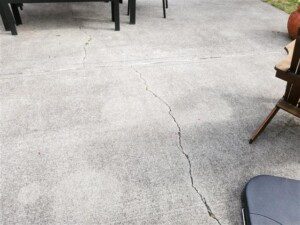If you own a home with concrete walkways, patios or driveway, then you probably know that concrete cracks are almost always inevitable. Concrete is an amazing building material that can be shaped and formed while in the liquid state, but then through a chemical process cures and becomes solid. Concrete has been an important building material for a long time, and has helped people to build structures such as bridges, tunnels, roads, and foundations for buildings.

There are several conditions that will lead to cracking of concrete. One of the most common cause is shrinkage. Shrinkage cracks form when the concrete cures. As it cures, the material shrinks. If one part of the concrete cures at a different rate than another part, cracks can form.
Another cause of concrete cracks is settling. Before concrete is poured, the ground below should be compacted. If the ground is not tamped down and compacted properly, the soil could settle once the concrete is poured. This could allow the concrete to settle, which causes cracks. In most cases, the soil will compact while settling, and then settlement will stop. However, if cracks are not sealed, water can get into the soil below the concrete which could lead to further settling due to saturated soil. Just like when you walk in mud, your foot will sink.
In colder climates that experience freezing temperatures, cracks can become larger when water freezes and expands. The force exhibited by water when it freezes is no match for concrete. Ice will always win, and will cause cracks to enlarge. In addition, locations with expansive soil (mostly clay), moisture buildup in the soil could cause it to expand, and then contract when it dries, which could cause major cracking and settling. These cycles could continue to the point where the concrete is cracked so much that the slab will need to be replaced. That type of repair is expensive and labor intensive. To avoid this, concrete cracks should be sealed as a preventative measure to prevent further cracking.
Sealing concrete cracks is an easy task that almost anyone can do. Using the proper materials and techniques can help to seal cracks and prevent moisture intrusion. With a little time and effort, you can seal cracks and protect your concrete slabs from further cracking and settling. If you do take on this task yourself, it is recommended to first try in a location that is not too visible (at the side or back of the house) so that you can get the hang of it. Your first try may not be as aesthetically pleasing, so try to avoid locations that may be visible at the front of the home.
Check out the video below on how to seal concrete cracks. There are several techniques that can be used to achieve a successful repair, but it is important to use the correct materials to ensure a proper seal.
